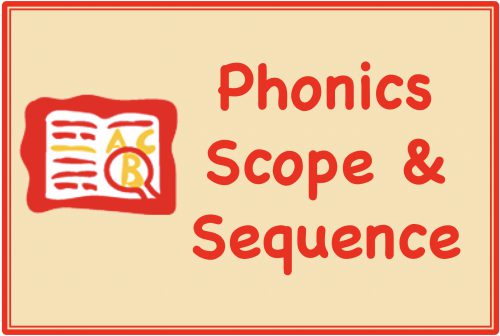Systematic Phonics Scope and Sequence

Phonics is one of the five components of reading identified in the National Reading Panel report (2000) and one of the major reading foundations standards found in the Common Core and similar state-specific literacy standards for kindergarten through grade 5. The Institute of Education Science research guide “Foundational Skills to Support Reading for Understanding in Kindergarten Through 3rd Grade” (Foorman et al., 2016) identifies phonics as a necessary component of early reading instruction. The guide notes that to effectively decode (read words) and encode (spell words), students must be able to identify individual sounds in words, name the letters of the alphabet, and identify each letter’s corresponding sounds. Once students know a few consonants and vowels, they can begin to apply their letter-sound knowledge to read words in isolation or connected text and spell words.
The alphabetic principle is at the heart of phonics instruction — the concept that letters and letter patterns represent the sounds of spoken language. When students understand the alphabetic principle, they have graphophonemic awareness. Phonics instruction helps children use the alphabetic principle to learn the relationship between the letters of written language and the sounds of spoken language. Phonics instruction teaches how the 26 letters of the English alphabet represent the 44 sounds (phonemes) in spoken English. Learning that there are predictable relationships between sounds and letters allows children to apply these relationships to both familiar and unfamiliar words and to begin to read with fluency.
Phonics is not a “program” — there are multiple ways to teach it. There is a significant body of research that finds the most effective type of phonics instruction to be explicit and systematic, especially for children who are at risk of reading difficulties (Adams, 1990; Chall, 1996; Lyon, 1998; National Reading Panel, 2000). Systematic phonics instruction follows a sequential and planned set of phonics elements that gradually builds from base elements to more subtle and complex structures. Teachers follow a scope and sequence, as opposed to implicit phonics instruction that addresses phonics as it comes up in text. English spelling can sometimes seem confusing because there are several ways to spell certain sounds. However, approximately 84% of English words are phonetically regular, and teaching the most common sound-letter relationships is useful for readers (Hanna et al., 1966). A systematic scope and sequence provides a guide for teaching a progression of these relationships.
What’s a good phonics scope and sequence?
While there is no universally agreed upon scope and sequence, any logically ordered sequence begins with the most basic phonics concepts and progresses to more difficult concepts, with new learning building on prior knowledge (Carreker, 2011). Sequences vary somewhat among phonics programs. If teachers are using an explicit, systematic phonics program it is best to follow its sequence for the order of teaching. If this is not the case, or if the program is not systematic enough, Keys to Literacy has developed a “generic” scope and sequence. It is used in Keys to Beginning Reading, a professional development program for elementary teachers that trains teachers to use evidence-based instructional practices for teaching all components of beginning reading instruction. The scope and sequence is organized into these categories: Pre-Alphabetic Principle (PreK-K), Alphabetic Principle and Phonics (K-1), and Phonics (1-3). Note that grade levels are suggested; there are variations around when the phonics concepts are introduced based on student needs. Click here to view and download a copy.
References:
Adams, M.J. (1990). Beginning to read: Thinking and learning about print. Cambridge, MA: The MIT Press.
Carreker, S. (2011). Teaching reading: Accurate decoding. In J. R. Birsh (Ed). Multisensory teaching of basic language skills, 3rd Edition. Baltimore, MD: Paul H Brookes.
Chall, J.S. (1996). Learning to read: The great debate (third edition). Fort Worth, TX: Harcourt Brace College Publishers.
Foorman, B., Beyler, N., Borradaile, K., Coyne, M., Denton, C. A., Dimino, J., Furgeson, J., Hayes, L., Henke, J., Justice, L., Keating, B., Lewis, W., Sattar, S., Streke, A., Wagner, R., & Wissel, S. (2016). Foundational skills to support reading for understanding in kindergarten through 3rd grade (NCEE 2016-4008). Washington, DC: National Center for Education Evaluation and Regional Assistance (NCEE), Institute of Education Sciences, U.S. Department of Education.
Hanna, P.R., Hodges, P.R., Hanna, J.L & Rudolph, E.H. (1966). Phoneme-grapheme correspondences as cues to spelling improvement. Washington, DC: U.W. Office of Education.
Lyon, R.G. (1998). Reading is not a natural process. Educational Leadership, 55, 6 pp 14-18.
National Institute of Child Health and Human Development. (2000). Report of the National Reading Panel. Teaching children to read: An evidence-based assessment of the scientific research literature on reading and its implications for reading instruction (NIH Publication No. 00-4769). Washington, DC: U.S. Government Printing Office.

 Joan Sedita is the founder of Keys to Literacy and author of the Keys to Literacy professional development programs. She is an experienced educator, nationally recognized speaker and teacher trainer. She has worked for over 35 years in the literacy education field and has presented to thousands of teachers and related professionals at schools, colleges, clinics, and professional conferences.
Joan Sedita is the founder of Keys to Literacy and author of the Keys to Literacy professional development programs. She is an experienced educator, nationally recognized speaker and teacher trainer. She has worked for over 35 years in the literacy education field and has presented to thousands of teachers and related professionals at schools, colleges, clinics, and professional conferences.
Thank you for this download and the informative articles you publish.
Thank you for your expertise, and sharing this scope and sequence.